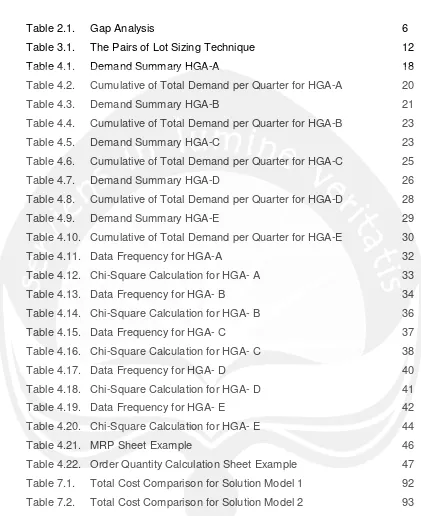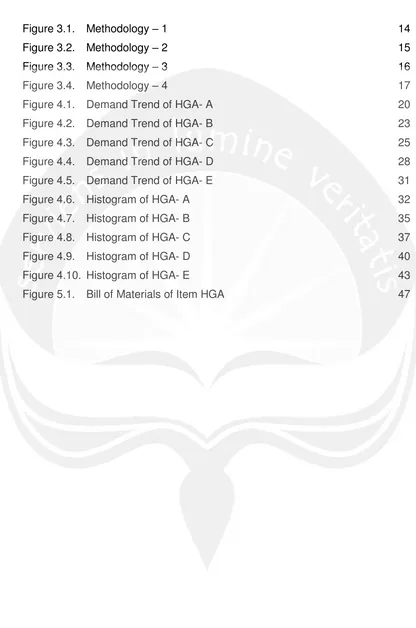AN APPROPRIATE LOT SIZING TECHNIQUE FOR INVENTORY POLICY
PROBLEM WITH DECREASING DEMAND
A THESIS
Submitted in Partial Fulfillment of the Requirement for the Bachelor Degree
of Engineering in Industrial Engineering
YOSAFAT NUGRAHA AJI PRATAMA
10 14 06103
INTERNATIONAL INDUSTRIAL ENGINEERING PROGRAM
DEPARTMENT OF INDUSTRIAL ENGINEERING
FACULTY OF INDUSTRIAL TECHNOLOGY
UNIVERSITAS ATMA JAYA YOGYAKARTA
DECLARATION OF ORIGINALITY
I certify that the research entitled “An Appropriate Lot Sizing Technique for
Inventory Policy Problem with Decreasing Demand” in this thesis has not been submitted for any other degree.
I certify that to the best of my knowledge and belief, this thesis which I wrote does not contain the works of parts of the works of other people, except those cited in the quotations and bibliography, as a scientific paper should.
In addition, I certify that I understand and abide the rule stated by the Ministry of Education and Culture of The Republic of Indonesia, subject to the provisions of Peraturan Menteri Pendidikan Nasional Republik Indonesia Nomor 17 Tahun 2010 tentang Pencegahan dan Penanggulangan Plagiat di Perguruan Tinggi.
Signature :
Student name : Yosafat Nugraha Aji Pratama Student ID : 10 14 06103
iv
ACKNOWLEDGEMENT
The author conducted the research on An Appropriate Lot Sizing Technique for Decreasing Demand Problem to fulfill partial requirement for bachelor degree of Industrial Engineer of Universitas Atma Jaya Yogyakarta.
The author would like to deliver highest appreciation to Mr. The Jin Ai, D. Eng and Mrs. Ririn Diar Astanti, D. Eng as the faculty supervisor and co-supervisor for the guidance while author is conducting this research.
The author would like to deliver highest appreciation to Mr. Baju Bawono, S.T., M.T. and Mrs. Slamet Setio Wigati, S.T., M.T. as the examiners for the corrections while author is conducting this research.
The deepest appreciation for love and dedication goes to the author‟s parents, Mr. Fransciscus Asisi Suratno and Mrs. Maria Eveta Sugiyati. Their love and dedication for the author give spirit to start, conduct and finally finish this research.
Special appreciation also given to author‟s brother, Leonardo Aji Nugraha for his support and help to author starts from the beginning of this research, conducting the research, and finally finish this research.
Great gratitude is given to Geovani Agnesia Somantry for her support in making a good presentation about this research.
Big appreciation goes to author‟s family, relatives and friends especially from
TABLE OF CONTENT
1.4. Scope and Limitation 3
2 Literature Review and Theoretical Background 4 2.1. Decreasing Demand Problem 4 2.2. Gap Analysis and Research Contribution 8 2.3. Lot Sizing Techniques 8
3 Methodology 11
3.1. Problem Identification 11
3.2. Literature Review 11
3.3. Model Development 12
3.4. Generating Solution Models 13
3.5. Result Analysis 13
3.6. Conclusion 13
4 Model Development 18
4.1. Data Characteristic 18
vi
4.3. Spreadsheet Model 42
5 Solution Model 1 46
5.1. MRP Sheet for HGAs 46
5.2. MRP Sheet for Suspensions 49
6 Solution Model 2 72
6.1. MRP Sheet for HGAs 72
6.2. MRP Sheet for Suspensions 81
7 Result Analysis 92
7.1. Result Analysis on Solution Model 1 92 7.2. Result Analysis on Solution Model 2 93
8 Conclusion 94
LIST OF TABLE
Table 2.1. Gap Analysis 6
viii
LIST OF FIGURE
LIST OF APPENDICES Appendix 11. MRP Sheet for HGA- A Using Least Unit Cost – Solution Model 1 Appendix 12. MRP Sheet for HGA- B Using Least Unit Cost – Solution Model 1 Appendix 13. MRP Sheet for HGA- C Using Least Unit Cost – Solution Model 1 Appendix 14. MRP Sheet for HGA- D Using Least Unit Cost – Solution Model 1 Appendix 15. MRP Sheet for HGA- E Using Least Unit Cost – Solution Model 1 Appendix 16. MRP Sheet for HGA- A Using Part Period Balancing – Solution
x Appendix 36. MRP Sheet for HGA- A Using Least Unit Cost – Solution Model 2 Appendix 37. MRP Sheet for HGA- B Using Least Unit Cost – Solution Model 2 Appendix 38. MRP Sheet for HGA- C Using Least Unit Cost – Solution Model 2 Appendix 39. MRP Sheet for HGA- D Using Least Unit Cost – Solution Model 2 Appendix 40. MRP Sheet for HGA- E Using Least Unit Cost – Solution Model 2 Appendix 41. MRP Sheet for HGA- A Using Part Period Balancing – Solution
ABSTRACT
The thesis entitled “An Appropriate Lot Sizing Technique for Decreasing
Demand Problem” began with problem in Materials Department of Hard Drive Manufacturer. They wanted to avoid the high total cost from ordering and holding the materials those were decreasing and at certain time would be in „end of life‟ phase. The problem was considered as decreasing demand problem with dependent demand characteristic and followed exponential distribution. The problem could be solved with Material Requirements Planning. One of the tools in Material Requirements Planning was Lot Sizing Technique. Lot Sizing Technique was used to determine the order quantity based on minimum Total Cost (Ordering and Holding Cost). There were only few researches conducting Lot Sizing Technique to solve inventory policy with decreasing demand. A research from Pujawan and Kingsman (1994) tried to solve Lumpy Demand problem using lot sizing technique. Their research was adapted to solve the decreasing demand problem with dependent demand characteristic. There were 5 lot sizing techniques applied in this research: Silver Meal 1, Silver Meal 2, Least Unit Cost, Part Period Balancing, and Incremental technique. There were 5 Suspensions analyzed in this research
Considering the dependent demand characteristic, there were 2 solution models applied to check which lot sizing technique gave the minimum total cost. First solution model treated the parents and components in different way, parents demand were solved using Lot For Lot technique, while the components were solved using 5 different lot sizing techniques. The result represented Incremental technique provided the lowest total cost. The second solution model treated the same way for both parents and components. They were solved by using 5 different Lot Sizing Techniques. The result represented Incremental technique provided the lowest total cost.
From those models, it could be concluded that: the inventory policy with decreasing demand problem and considered as dependent demand solved by using Incremental lot sizing technique.

